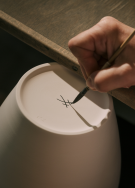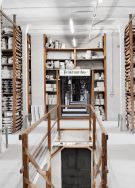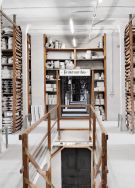
„To this day, Meissen porcelain is created by hand employing only traditional techniques. Our Demonstration Workshops offer insight into its creation and decoration.“
Potter
Every round piece of Meissen porcelain first takes shape on the manufactory’s spinning wheels, under the expert fingers of Meissen’s potters. Unlike industrially produced porcelain, all Meissen plates, cups, and vases are still thrown by hand today – a time-consuming process, which results in more delicate pieces. First the porcelain paste is turned until it is formed to the appropriate shape, at which point it is gently pressed into a plaster mould, which lends the pieces its contours and silhouette. Little by little, the plaster mould absorbs the water from the porcelain paste, allowing the porcelain mass to solidify. Meissen figurines and certain dishware pieces are made up of multiple parts that are formed individually or moulded, dried, and then assembled by the embossers. Cups are made from up to five pieces, while complex statues can be made of up to 100.


Embosser
Meissen’s embossers are responsible for turning the large number of components into a figurine or statue. They use slurry, a liquid porcelain paste, a great deal of skill, and the utmost precision to assemble the individual pieces. Smaller decorative elements such as leaves, flowers, and scallops are formed by hand using a wooden mould and then attached to the figurine. In the final stage of this step, using different tools, they flesh out details such as individual ringlets or a figure’s expression, and also retouch all of the seams. Embossers bring out a piece’s finer aspects and make the final touches in accordance with the modeller’s vision. This requires a great deal of artistic talent.
„How is Meissen porcelain made? How many pieces does it take to make a figurine? How are the Swords applied under the glaze? Our Demonstration Workshops offers all the answers.“
Under-glaze painting
After the first firing, the porcelain is hard enough to be handled and has a porous surface. This is when under-glaze painting occurs. The range of colours available for under-glaze painting is smaller than for on-glaze paints because very few pigments can withstand the high temperatures required for the second, or glost firing. The most famous example is cobalt blue, used to create Meissen’s iconic “Onion Pattern” as well as its infamous Crossed Swords. This colour bonds to the porcelain during the glost firing, which means it is protected by the glaze in the next step, thus testifying to the authenticity and quality of Meissen porcelain. The glaze and all under-glaze paints are made in-house at the Meissen manufactory.


On-glaze painting
For on-glaze painting, colours are applied by hand to the glaze of the glost-fired porcelain. For this process, Meissen’s artisans mix coloured powder with turpentine to create the paint, and then apply it to the porcelain. Complex designs require multiple firings and paint applications. From chinoiseries to flowers and blossoms, from figures and landscapes all the way to animals and fruits – given the wide range of decorative motives, every Meissen porcelain painter must be specialized in their own area. Models and templates guarantee the artistic authenticity of the finished object. All of the colours used are based on formulas from the archives of Meissen’s paint laboratory. The final decorative firing allows the on-glaze paints to truly shine.
Events







